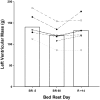Left ventricular remodeling during and after 60 days of sedentary head-down bed rest
- PMID: 26494448
- PMCID: PMC4835908
- DOI: 10.1152/japplphysiol.00676.2015
Left ventricular remodeling during and after 60 days of sedentary head-down bed rest
Abstract
Short periods of weightlessness are associated with reduced stroke volume and left ventricular (LV) mass that appear rapidly and are thought to be largely dependent on plasma volume. The magnitude of these cardiac adaptations are even greater after prolonged periods of simulated weightlessness, but the time course during and the recovery from bed rest has not been previously described. We collected serial measures of plasma volume (PV, carbon monoxide rebreathing) and LV structure and function [tissue Doppler imaging, three-dimensional (3-D) and 2-D echocardiography] before, during, and up to 2 wk after 60 days of 6° head down tilt bed rest (HDTBR) in seven healthy subjects (four men, three women). By 60 days of HDTBR, PV was markedly reduced (2.7 ± 0.3 vs. 2.3 ± 0.3 liters,P< 0.001). Resting measures of LV volume and mass were ∼15% (P< 0.001) and ∼14% lower (P< 0.001), respectively, compared with pre-HDTBR values. After 3 days of reambulation, both PV and LV volumes were not different than pre-HDTBR values. However, LV mass did not recover with normalization of PV and remained 12 ± 4% lower than pre-bed rest values (P< 0.001). As previously reported, decreased PV and LV volume precede and likely contribute to cardiac atrophy during prolonged LV unloading. Although PV and LV volume recover rapidly after HDTBR, there is no concomitant normalization of LV mass. These results demonstrate that reduced LV mass in response to prolonged simulated weightlessness is not a simple effect of tissue dehydration, but rather true LV muscle atrophy that persists well into recovery.
Keywords: cardiac atrophy; cardiovascular physiology; echocardiography; space flight.
Figures




Similar articles
-
Deterioration of left ventricular chamber performance after bed rest : "cardiovascular deconditioning" or hypovolemia?Circulation. 2001 Apr 10;103(14):1851-7. doi: 10.1161/01.cir.103.14.1851. Circulation. 2001. PMID: 11294802 Clinical Trial.
-
Cardiac atrophy in women following bed rest.J Appl Physiol (1985). 2007 Jul;103(1):8-16. doi: 10.1152/japplphysiol.01162.2006. Epub 2007 Mar 22. J Appl Physiol (1985). 2007. PMID: 17379748 Clinical Trial.
-
Cardiac atrophy after bed rest and spaceflight.J Appl Physiol (1985). 2001 Aug;91(2):645-53. doi: 10.1152/jappl.2001.91.2.645. J Appl Physiol (1985). 2001. PMID: 11457776
-
Long-duration bed rest as an analog to microgravity.J Appl Physiol (1985). 2016 Apr 15;120(8):891-903. doi: 10.1152/japplphysiol.00935.2015. Epub 2016 Feb 18. J Appl Physiol (1985). 2016. PMID: 26893033 Review.
-
Analogs of microgravity: head-down tilt and water immersion.J Appl Physiol (1985). 2016 Apr 15;120(8):904-14. doi: 10.1152/japplphysiol.00986.2015. Epub 2016 Feb 11. J Appl Physiol (1985). 2016. PMID: 26869710 Review.
Cited by
-
Simulated Microgravity and Recovery-Induced Remodeling of the Left and Right Ventricle.Front Physiol. 2016 Jun 29;7:274. doi: 10.3389/fphys.2016.00274. eCollection 2016. Front Physiol. 2016. PMID: 27445861 Free PMC article.
-
Effects of weightlessness on the cardiovascular system: a systematic review and meta-analysis.Front Physiol. 2024 Jul 26;15:1438089. doi: 10.3389/fphys.2024.1438089. eCollection 2024. Front Physiol. 2024. PMID: 39129756 Free PMC article.
-
Simulated Microgravity Alters Gene Regulation Linked to Immunity and Cardiovascular Disease.Genes (Basel). 2024 Jul 24;15(8):975. doi: 10.3390/genes15080975. Genes (Basel). 2024. PMID: 39202335 Free PMC article.
-
Intensified training augments cardiac function, but not blood volume, in male youth elite ice hockey team players.Exp Physiol. 2025 May;110(5):755-766. doi: 10.1113/EP091674. Epub 2024 Jul 16. Exp Physiol. 2025. PMID: 39014554 Free PMC article.
-
WWP1 Deficiency Alleviates Cardiac Remodeling Induced by Simulated Microgravity.Front Cell Dev Biol. 2021 Oct 18;9:739944. doi: 10.3389/fcell.2021.739944. eCollection 2021. Front Cell Dev Biol. 2021. PMID: 34733849 Free PMC article.
References
-
- Alfrey CP, Udden MM, Huntoon CL, Driscoll T. Destruction of newly released red blood cells in space flight. Med Sci Sports Exerc 28: S42–S44, 1996. - PubMed
-
- Arbeille P, Fomina G, Roumy J, Alferova I, Tobal N, Herault S. Adaptation of the left heart, cerebral and femoral arteries, and jugular and femoral veins during short- and long-term head-down tilt and spaceflights. Eur J Appl Physiol 86: 157–168, 2001. - PubMed
-
- Bringard A, Pogliaghi S, Adami A, De Roia G, Lador F, Lucini D, Pizzinelli P, Capelli C, Ferretti G. Cardiovascular determinants of maximal oxygen consumption in upright and supine posture at the end of prolonged bed rest in humans. Respir Physiol Neurobiol 172: 53–62, 2010. - PubMed
-
- Buckey JC, Gaffney FA, Lane LD, Levine BD, Watenpaugh DE, Wright SJ, Yancy CW, Meyer DM, Blomqvist CG. Central venous pressure in space. J Appl Physiol 81: 19–25, 1996. - PubMed
Publication types
MeSH terms
Grants and funding
LinkOut - more resources
Full Text Sources
Other Literature Sources
Research Materials

